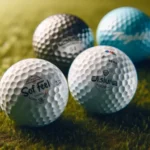When it comes to playing tennis, the right equipment can make all the difference, and one of the most essential yet often overlooked components is the tennis ball.
With a wide variety of options available, from pressureless to felt-covered, and differences in bounce, durability, and speed, selecting the perfect tennis ball can feel overwhelming. Whether you’re a seasoned player aiming for that competitive edge, a casual weekend warrior looking to enjoy a relaxed match, or a coach seeking the best options for your players, understanding the nuances of tennis balls is crucial for enhancing your game. In this ultimate guide, we’ll explore the various types of tennis balls, their features, and how to choose the right one tailored to your playing style and preferences. Get ready to elevate your tennis experience and ensure that every serve, volley, and rally is played with the perfect ball!
1. Introduction to Tennis Balls: Understanding the Basics

Tennis balls might seem like simple, everyday objects, but they are the unsung heroes of the game, playing a crucial role in your performance on the court. Understanding the basics of tennis balls is essential for players of all levels, whether you’re a beginner just starting out or a seasoned competitor looking to fine-tune your game.
At first glance, a tennis ball is a fuzzy, brightly colored sphere, but its design is far more intricate than it appears. The standard tennis ball is covered with a durable felt material, typically made from a blend of wool or nylon, which not only gives it that iconic look but also influences its bounce and spin. Inside, a pressurized core filled with air or nitrogen helps maintain the ball’s firmness and resilience, allowing it to withstand intense rallies and powerful serves.
As you delve deeper into the world of tennis balls, you’ll discover that not all balls are created equal. Different types of balls are tailored for various playing surfaces—hard courts, clay courts, and grass—each affecting how the ball behaves during play. For example, a hard court ball is designed to withstand the abrasive surface and provide a consistent bounce, while a clay court ball is often made with a softer felt to reduce friction and enhance control.
Moreover, not every player has the same needs. Beginners may benefit from balls that are designed for slower play, such as low-compression or oversized balls, which offer a larger hitting surface and help build confidence. On the other hand, advanced players may prefer high-performance balls that cater to speed and spin, allowing for more aggressive gameplay.
In this guide, we’ll explore the various types of tennis balls available, their specific features, and how to choose the right one to elevate your game. Whether you’re looking for the perfect ball to match your playing style or simply want to gain a better understanding of what makes a great tennis ball, this comprehensive overview will serve as your go-to resource. So, let’s dive in and discover the essential elements that can enhance your experience on the court!
2. Types of Tennis Balls: Regular Duty vs. Extra Duty
When it comes to selecting the right tennis balls for your game, understanding the difference between regular duty and extra duty options is crucial. Each type is designed with specific playing conditions in mind, ensuring that you have the best possible experience on the court.
**Regular Duty Tennis Balls** are ideal for use on indoor courts or softer surfaces like clay. These balls have a thinner felt covering, which allows them to respond better to the softer playing conditions. The lighter fabric helps minimize fluff build-up, ensuring consistent playability and predictable bounce during longer matches. If you frequently play at indoor facilities or on clay courts, opting for regular duty balls will enhance your performance and feel, allowing for a more controlled game.
On the other hand, **Extra Duty Tennis Balls** are crafted for outdoor play, particularly on hard courts. Featuring a thicker felt, these balls are designed to withstand the harsher conditions of outdoor play. The robust material helps them resist wear and tear from abrasive surfaces, meaning they maintain their bounce and playability longer than their regular duty counterparts. If you’re someone who frequently plays on hard courts, whether it’s asphalt or concrete, choosing extra duty tennis balls will ensure your equipment can keep up with the demanding environment.
In summary, the choice between regular duty and extra duty tennis balls boils down to the type of surface you play on and your personal preferences. Understanding these distinctions allows you to select the perfect ball for your game, ensuring you enjoy every serve, volley, and rally to the fullest. Whether you prefer the finesse of regular duty or the durability of extra duty, making an informed choice will elevate your overall tennis experience.
3. The Importance of Pressure: Pressurized vs. Pressureless Balls

When it comes to tennis balls, one of the most significant factors influencing your game is the internal pressure of the ball. Understanding the difference between pressurized and pressureless balls is crucial for selecting the right type that complements your playing style and level.
**Pressurized Balls**
Pressurized tennis balls are the most commonly used type, specifically designed for competitive play. These balls are filled with air, giving them a lively bounce and optimal speed when struck. The pressure inside the ball allows it to maintain its shape and responsiveness, making it ideal for players who thrive on fast-paced rallies and explosive serves. However, it’s important to note that this pressurized state is not permanent. Over time, the air inside the ball will escape, causing it to lose its bounce and performance quality. Typically, pressurized balls are best suited for those who play frequently, as they require regular replacement to ensure peak performance.
**Pressureless Balls**
On the other hand, pressureless tennis balls are designed for longevity rather than immediate playability. These balls are constructed without internal pressure, which means they maintain their shape longer and can withstand heavy use. While they tend to have a heavier feel and a lower bounce compared to their pressurized counterparts, pressureless balls are excellent for practice sessions, especially for beginners or players who engage in frequent drills. They are also a favorite choice for recreational players who may not play often enough to justify the continuous purchase of pressurized balls.
Ultimately, the choice between pressurized and pressureless balls depends on your playing frequency, skill level, and personal preferences. If you’re looking for that quick, energetic response during matches, pressurized balls are the way to go. However, if you want a durable option for casual practice without the need for constant replacement, pressureless balls could be your best bet. By understanding the importance of pressure in tennis balls, you can make a more informed decision that enhances your overall game experience.
4. Choosing the Right Tennis Ball for Your Skill Level
When it comes to selecting the perfect tennis ball for your skill level, understanding the various types available is crucial. Tennis balls are not a one-size-fits-all product; they are designed with specific characteristics to enhance the playing experience for different skill levels, from novice to professional.
For beginners, opting for a slower, softer ball can significantly improve your experience on the court. These balls, often labeled as “low-compression” or “beginner” balls, are designed to bounce lower and travel slower, allowing new players more time to react and develop their strokes. Look for balls with a bright color and a fuzzy exterior, as they provide better visibility and a softer feel upon impact. Brands like Wilson and Penn offer excellent options that cater specifically to novice players.
As players progress to an intermediate level, they may want to use regular tennis balls that offer a balance of speed and control. These standard balls are made with a higher compression, providing a livelier bounce that helps players practice their timing and shot placement. Many recreational players gravitate towards the classic yellow balls that are commonly found at local clubs and courts—these are the quintessential tennis balls that offer a well-rounded performance for those looking to refine their skills.
For advanced players, the choice of tennis balls becomes even more critical. Competitive players often prefer high-performance balls that provide superior consistency and durability. These balls are engineered to withstand rigorous play and maintain their bounce and feel over time. Look for brands that produce tournament-grade balls, designed to meet the standards of professional play. The Wilson US Open and Dunlop Fort tournament balls are popular choices among serious athletes seeking that extra edge in their game.
Ultimately, selecting the right tennis ball is about understanding your current skill level and the type of experience you wish to cultivate on the court. By matching your choice of ball to your abilities, you can enhance your performance, enjoy the game more fully, and set yourself up for continuous improvement as you progress.
5. Factors to Consider: Playing Surface and Conditions

When selecting the perfect tennis balls for your game, one of the most critical factors to consider is the playing surface and the conditions in which you’ll be playing. These elements can significantly influence the performance and longevity of the balls, as well as your overall playing experience.
**Playing Surface:** Tennis courts are typically categorized into three main types: hard courts, clay courts, and grass courts. Each surface interacts differently with tennis balls.
– **Hard Courts:** These are perhaps the most common surfaces, made of concrete or asphalt. They offer a consistent bounce and speed, which is why many players prefer them. For hard court play, opt for tennis balls that are specifically designed for this surface, often labeled as “hard court” balls. These balls tend to have a thicker felt that withstands the abrasive nature of hard surfaces, ensuring they maintain their bounce and playability longer.
– **Clay Courts:** If you play on clay, you’ll want to look for balls that are designed to perform best in these conditions. Clay courts slow down the ball and cause it to bounce higher, so choosing a ball that is softer and has a more fibrous felt can enhance your game. These balls are typically drier and can become heavier when damp, affecting their performance.
– **Grass Courts:** Known for their fast play and lower bounce, grass courts require specialized balls as well. The best choice here is a ball that can maintain its performance despite the slippery surface. Grass court balls often have a thicker covering to resist wear from the grass and to provide better grip.
**Playing Conditions:** Beyond the surface, consider the environmental conditions in which you’ll be playing. Are you facing hot, dry weather or cooler, humid conditions? High temperatures can cause tennis balls to lose pressure quickly, while humidity can cause them to absorb moisture and become heavier.
For example, in hotter climates, you might prefer balls that are labeled as “extra duty,” as they are constructed to withstand the heat and maintain their bounce longer. Conversely, in cooler, damp conditions, you might lean towards “regular duty” balls, designed for better performance in such environments.
By carefully considering both the surface and playing conditions, you’ll be able to choose tennis balls that not only enhance your performance but also improve your enjoyment of the game. With the right balls in hand, you can step onto the court with confidence, ready to tackle any match that comes your way.
6. Top Brands in the Market: A Quick Comparison
When it comes to selecting the perfect tennis balls for your game, understanding the top brands in the market can make all the difference. Different brands cater to various playing styles, surfaces, and skill levels, so knowing what each offers can help you make an informed decision.
**Wilson**: Renowned for its innovation, Wilson tennis balls are a favorite among both recreational players and professionals. Their US Open and Championship lines are particularly popular for their durability and consistent performance. These balls are designed to provide excellent bounce and a true feel on the court, making them ideal for players who value precision.
**Dunlop**: Known for their high-quality construction, Dunlop tennis balls are a staple in many players’ bags. The Dunlop Fort and the Dunlop Revolution lines are designed with advanced technologies that enhance durability and performance on various surfaces. These balls are often praised for their visibility and the speed they offer, making them a great choice for competitive players.
**Babolat**: If you’re looking for balls that offer exceptional control and spin, Babolat is a brand worth considering. Their French-made balls are designed for players who prioritize feel and touch, making them ideal for those who enjoy playing at a higher level. The Babolat Gold and Team lines deliver consistent performance and are well-suited for clay and hard courts alike.
**Penn**: A staple in the American tennis scene, Penn balls are known for their affordability without compromising quality. Their regular duty and extra duty variations cater to different court surfaces, ensuring that players can find the right option for their playing conditions. Penn balls are often favored for practice sessions, thanks to their reliability and cost-effectiveness.
**Head**: Head tennis balls are synonymous with performance, making them a popular choice among both amateurs and professionals. Their Head Championship and Head Pro lines are known for their high bounce and control, making them suitable for players who enjoy an aggressive style of play. These balls are crafted to maintain their performance over time, even after prolonged use.
In summary, while selecting tennis balls, consider the brand that aligns with your playing style, the surfaces you frequent, and your skill level. Whether you prioritize durability, spin, or control, understanding the strengths of these top brands will ensure you find the perfect tennis balls to elevate your game.
7. Understanding Ball Color and Visibility

When it comes to selecting the right tennis balls for your game, the color and visibility of the ball can significantly impact your performance on the court. Traditionally, tennis balls are bright yellow, a hue chosen for its high visibility against both the green and blue backgrounds of standard tennis courts. This vibrant color helps players track the ball with greater ease during fast-paced rallies, ensuring that you can react quickly and make those crucial returns.
However, not all tennis balls are created equal when it comes to visibility. Some players may prefer balls in different shades, such as neon green, orange, or even pink. These alternative colors can provide a unique visual experience, particularly in varying light conditions or on courts that may not contrast well with the standard yellow ball. For example, if you often play in dimly lit environments or during twilight hours, experimenting with brighter or more fluorescent options might enhance your visibility and overall play.
Moreover, consider the psychological aspect of color. Bright colors can evoke a sense of energy and motivation, which may help boost your confidence during matches. On the other hand, if you find that certain colors distract you or disrupt your focus, it’s important to choose balls that align with your comfort and concentration levels.
Additionally, the surface you play on can also influence your choice. On grass courts, where the green backdrop can sometimes blend with the yellow ball, you might find that an alternative color stands out better, helping you maintain your edge during gameplay.
Ultimately, understanding the impact of ball color on visibility is about finding what works best for you. Whether you stick to the classic yellow or venture into more unconventional colors, ensuring that you can clearly see and track your tennis balls is a crucial step in enhancing your performance and enjoyment of the game. So, as you gear up for your next match, take a moment to consider how color can elevate your play and keep you at the top of your game.
8. How to Test Tennis Balls for Quality and Performance
When it comes to selecting the best tennis balls for your game, understanding how to test their quality and performance can make all the difference. A great tennis ball should not only feel good in your hand but also perform consistently on the court. Here are some essential methods to evaluate tennis balls to ensure you’re making an informed choice.
**1. Visual Inspection:** Start by examining the exterior of the balls. Look for any visible defects such as dents, discoloration, or uneven fuzz. High-quality tennis balls should have a uniform surface, with vibrant felt that feels soft yet durable. The seams should be tightly stitched, ensuring that the ball maintains its shape over time.
**2. Bounce Test:** A fundamental aspect of a tennis ball’s performance is its bounce. To conduct a bounce test, drop the ball from a height of about 4 feet onto a hard surface. A quality tennis ball should bounce back to a height of approximately 50-60% of its drop height. If the ball fails to bounce adequately or feels flat, it may not provide the performance you need during matches.
**3. Playability Check:** The ultimate test comes when you hit the courts. Bring a few balls with you to a practice session and assess how they feel when struck with your racket. Pay attention to the sound they make upon contact—good quality balls produce a satisfying “pop” that indicates solid construction. Additionally, observe the ball’s speed and spin; it should respond well to your strokes, offering a balance of control and power.
**4. Longevity Assessment:** After a few practice sessions, consider how well the balls hold up over time. Quality tennis balls should maintain their bounce and feel, even after extended use. If you notice that they quickly lose their pressure or fuzz, it might be a sign that the balls aren’t built to last.
**5. Brand Reputation:** Finally, consider the brand behind the tennis balls. Established brands often invest in research and development to create products that meet the needs of players at all levels. Read reviews, seek recommendations from fellow players, and don’t hesitate to try out different brands to find the one that aligns with your playing style.
By taking the time to thoroughly test and evaluate your tennis balls before making a purchase, you can ensure that you select the perfect ones that will enhance your game and keep you coming back for more on the court.
9. Environmental Impact: Eco-friendly Options
In today’s environmentally conscious world, the materials and production processes of the products we use are more important than ever. As a tennis player, choosing eco-friendly tennis balls not only enhances your game but also minimizes your impact on the planet. Many traditional tennis balls are made with synthetic rubber and covered in a layer of felt, both of which can take years to decompose and contribute to landfill waste.
Fortunately, the tennis industry is responding to this growing concern by introducing a variety of eco-friendly options. These sustainable tennis balls are often made from natural rubber and organic materials, ensuring that they biodegrade much more quickly than their conventional counterparts. Brands like Wilson and Babolat are leading the charge, offering tennis balls crafted from recycled materials and packaged in environmentally friendly containers.
Additionally, some companies have developed innovative ways to repurpose used tennis balls, turning them into new products such as insulation, flooring, and even sports equipment. By choosing eco-friendly balls, you not only enjoy a high-quality playing experience but also support a circular economy that values sustainability.
When selecting your tennis balls, consider the long-term impact of your purchase. Look for certifications or labels that indicate eco-friendly practices, and opt for brands that prioritize sustainability in their manufacturing processes. By making a conscious choice, you can enjoy your game while also contributing to a healthier planet for future generations. Embrace the green revolution in tennis; it’s a step toward a more sustainable approach to sports that you and your fellow players can feel good about.
10. Common Myths About Tennis Balls Debunked
When it comes to tennis, misconceptions about equipment can lead to unnecessary confusion and poor performance on the court. Understanding the truth behind these myths is essential for players of all levels who want to select the right tennis balls for their game. Here, we debunk some of the most common myths surrounding tennis balls, helping you make informed choices.
**Myth 1: All Tennis Balls Are Created Equal**
Many new players assume that any tennis ball will suffice for their game, but this couldn’t be further from the truth. Different balls are designed for various surfaces—such as hard courts, clay, or grass—and come in different grades, including beginner, intermediate, and professional. Using the wrong type can affect your play and overall enjoyment of the game.
**Myth 2: More Pressure Means Better Performance**
Another common misconception is that balls with higher internal pressure will always perform better. While it’s true that pressure affects bounce, over-inflated balls can lead to a harder hit, causing injury or discomfort during play. Opt for a pressure that feels comfortable and suits your playing style rather than seeking maximum bounce at all costs.
**Myth 3: Old Balls Are Just as Good as New Ones**
Many players hold onto used tennis balls longer than they should, thinking they can still perform well. However, as balls age, they lose their bounce and can become fuzzy, making them unpredictable. For consistent performance, it’s best to replace your tennis balls regularly, especially if you’re playing competitively or frequently.
**Myth 4: All Brands Are the Same**
With numerous brands on the market, it’s easy to assume they all produce similar quality balls. In reality, different manufacturers use varying materials and technologies that can drastically affect performance. Testing out a few brands can help you find the one that complements your style of play.
By dispelling these myths, you can approach your next tennis purchase with greater knowledge and confidence. Choosing the right tennis balls tailored to your game will not only enhance your performance but also increase your enjoyment on the court. Remember, informed decisions lead to better gameplay, so don’t let misconceptions hold you back!
11. Maintaining Your Tennis Balls: Tips for Longevity
Maintaining your tennis balls properly can significantly extend their lifespan, ensuring you get the most out of your investment and ultimately enhancing your game. Here are some essential tips to help you care for your tennis balls effectively.
First and foremost, consider the storage conditions. Store your tennis balls in a cool, dry place away from direct sunlight, as excessive heat can degrade the rubber and felt, leading to a loss of bounce. Ideally, keep them in a pressurized container to help maintain their firmness. Specialized tennis ball tubes are available that mimic the pressure of a can, which can be a game changer for preserving their quality over time.
Another crucial aspect is to avoid exposing your tennis balls to harsh surfaces. While it’s tempting to play on every available court, be mindful of the surface material. Hard courts can wear down the felt more quickly than clay or grass courts, so try to reserve your premium balls for matches on softer surfaces when possible. Additionally, if you notice that a ball has picked up excessive dirt or debris, give it a quick rinse with water and a gentle scrub before your next match. This will not only keep them clean but also prevent dirt from damaging the felt and affecting their performance.
Regularly rotate your tennis balls during play. Using a single ball for an entire session can lead to uneven wear and tear. Instead, break out a few balls and switch them out periodically. This will ensure a more consistent playing experience and help to balance out any wear across all the balls.
Lastly, pay attention to signs of wear. If a ball feels flat or lacks bounce, it’s time to replace it. Investing in a quality ball is important, but so is knowing when to let go. By following these simple maintenance tips, you’ll ensure that your tennis balls not only last longer but also perform at their best, allowing you to focus on your game and enjoy every match to the fullest.
12. Recommendations for Beginners vs. Advanced Players
When it comes to selecting the right tennis balls, understanding the differences between the needs of beginners and advanced players is crucial for enhancing performance and enjoyment on the court.
**For Beginners:** New players often benefit from softer, more forgiving balls that allow for better control and ease of play. Opting for low-compression balls, such as the USTA-approved QuickStart balls, can be a game-changer. These balls are larger and bounce lower, helping beginners develop their skills without the frustration that can come from faster, harder balls. They also provide ample time to react, allowing for proper swing mechanics to be practiced. Additionally, choosing bright-colored balls can enhance visibility, making it easier for newcomers to track the ball during rallies.
**For Advanced Players:** Once players have honed their skills, they often prefer standard, high-performance tennis balls designed for speed and spin. These balls are typically made with a consistent felt covering that ensures a predictable bounce and a durable core that withstands the intensity of competitive play. Brands such as Wilson and Penn offer premium options that cater to advanced players, delivering the responsiveness needed for powerful serves and precise volleys. Additionally, players at this level often have personal preferences regarding the heaviness and firmness of the ball, which can significantly impact their overall game strategy.
Understanding these distinctions not only helps in selecting the right tennis balls but also fosters a more enjoyable and effective playing experience, encouraging both beginners and advanced players to thrive in their tennis journeys. Whether you’re just starting or looking to refine your skills, matching the right ball to your level can make all the difference on the court.
13. When to Replace Your Tennis Balls: Signs to Look For
Knowing when to replace your tennis balls is crucial to maintaining the quality of your game. While it might be tempting to continue using the same set until they’re completely deflated, there are several signs that indicate it’s time to retire your trusty balls and invest in a fresh batch.
First and foremost, pay attention to the feel of the balls. If they seem flat or lack the usual bounce, it’s a clear sign that they have lost their internal pressure. A good tennis ball should spring back when dropped from a height of about three feet. If it thuds heavily upon impact, it’s time for a change.
Next, inspect the outer felt covering. If you notice any major wear and tear—such as fraying or bald patches—this can affect the ball’s aerodynamics and spin, leading to less control during your game. A well-maintained ball should have a consistent, fuzzy surface that enhances grip and reduces slippage.
Additionally, consider the color. New tennis balls are typically bright yellow or fluorescent green, offering excellent visibility on the court. Over time, however, they can fade to a duller shade. Faded balls not only lose their aesthetic appeal but may also impact your ability to track the ball’s movement, particularly in fast-paced exchanges.
Lastly, if you’ve been using the same balls for a while, even if they appear visually intact, it’s good practice to rotate them out every few weeks, especially if you play frequently. Regularly replacing your tennis balls not only enhances your performance but also prolongs the life of your racquet strings and keeps the game enjoyable.
By staying vigilant and recognizing these signs, you can ensure that you’re always playing with the best equipment, allowing you to focus on improving your skills and enjoying every match.
14. Conclusion: Making the Best Choice for Your Game
In conclusion, selecting the right tennis balls can significantly enhance your game and overall enjoyment on the court. With so many options available—ranging from pressureless balls that endure longer, to high-performance options designed for competitive play—it’s crucial to consider your skill level, playing style, and the specific conditions in which you’ll be playing.
Remember, the right tennis ball can affect not just your performance, but also the dynamics of your matches. Whether you’re a recreational player enjoying a casual game with friends or a competitive athlete preparing for a tournament, taking the time to choose the appropriate tennis balls tailored to your needs can lead to improved play and greater satisfaction.
As you embark on your next shopping trip or online purchase, keep in mind the factors we’ve discussed: the type of court surface, the ball’s felt composition, and your personal preferences regarding bounce and durability. Don’t hesitate to experiment with different brands and types until you find the perfect match.
Ultimately, your choice of tennis balls should feel as natural as your swing and add to the joy of playing. Armed with this knowledge, you’re now ready to make an informed decision that will not only elevate your game but also ensure that every match is a memorable one. Happy playing!
15. Additional Resources: Where to Buy and Further Reading
When it comes to choosing the perfect tennis balls for your game, having the right resources at your fingertips can make all the difference. The market is teeming with options, and understanding where to buy quality tennis balls, along with supplementary reading materials, can enhance your shopping experience and overall performance on the court.
### Where to Buy Tennis Balls
You can find tennis balls in various places, each offering its own advantages. **Local Sporting Goods Stores:** These are great for hands-on shopping. You can feel the balls, check their bounce, and often find expert staff who can provide personalized recommendations based on your playing style.
**Online Retailers:** Websites like Amazon, Tennis Warehouse, and Dick’s Sporting Goods offer a wide selection of brands and types, often with customer reviews that can guide your decision. Online shopping also allows you to easily compare prices and find bulk deals, which can be especially beneficial if you play frequently.
**Specialty Tennis Shops:** If you’re looking for premium or specific types of tennis balls, such as those designed for clay courts or high-altitude play, specialty shops can be invaluable. These retailers often carry niche products that larger stores may not stock.
**Membership Clubs:** Many tennis clubs and academies have pro shops that offer quality tennis balls at competitive prices, along with the advantage of being able to chat with experts who can help you find the perfect fit for your game.
### Further Reading
To deepen your understanding of tennis balls and their impact on your play, consider exploring the following resources:
1. **Tennis Magazine**: This publication regularly features articles on equipment, including tennis balls, and how they can influence your game.
2. **USPTA (United States Professional Tennis Association)**: Their website provides valuable insights into choosing the right equipment based on your skill level and playing style.
3. **Tennis.com**: A go-to resource for everything tennis, this site offers gear reviews, expert advice, and articles that delve into the science behind different types of tennis balls.
4. **YouTube Tutorials**: Many tennis professionals and enthusiasts share their tips and experiences, offering visual demonstrations on how different balls can affect your performance.
By leveraging these resources, you’ll be well-equipped to make informed choices about which tennis balls will elevate your game and keep you enjoying every match. Whether you’re a seasoned player or just starting out, the right ball can make all the difference in your performance and enjoyment of the sport.
As we conclude our ultimate guide to choosing the perfect tennis balls for your game, we hope you’ve gained valuable insights that will elevate your performance on the court. Selecting the right tennis ball is more than just a matter of preference; it can significantly impact your play style, ball control, and overall enjoyment of the game. Whether you’re a seasoned player or just starting out, understanding the differences in ball types, textures, and pressures will empower you to make informed choices that align with your skill level and playing conditions. So, as you gear up for your next match, remember to consider the tips and recommendations shared in this guide. Here’s to finding the perfect tennis ball that complements your game and brings you one step closer to victory! Happy playing!






